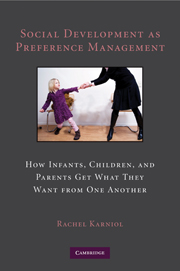 Social Development as Preference Management
Social Development as Preference Management Book contents
- Frontmatter
- Contents
- Acknowledgments
- Introduction
- 1 The Baby “Preference Game”
- 2 Children's Expression of Preferences
- 3 Emerging Meta-Preferences
- 4 Other People's Preferences
- 5 Parenting and Preference Management
- 6 Channeling Children's Preferences
- 7 Temporizing Preferences
- 8 Restricting Children's Preferences
- 9 Disciplining Noncompliance
- 10 Planes of Transformational Thought: Temporal, Imaginal, and Mental
- 11 Manipulating Others
- 12 Coping and Self-Regulating
- 13 Mind Play: Applying Transformational Thought
- 14 Minding One's Own Versus Others' Preferences: Altruism, Aggression, and Morality
- 15 Tying Up
- References
- Subject Index
- Name Index
6 - Channeling Children's Preferences
Published online by Cambridge University Press: 05 June 2012
- Frontmatter
- Contents
- Acknowledgments
- Introduction
- 1 The Baby “Preference Game”
- 2 Children's Expression of Preferences
- 3 Emerging Meta-Preferences
- 4 Other People's Preferences
- 5 Parenting and Preference Management
- 6 Channeling Children's Preferences
- 7 Temporizing Preferences
- 8 Restricting Children's Preferences
- 9 Disciplining Noncompliance
- 10 Planes of Transformational Thought: Temporal, Imaginal, and Mental
- 11 Manipulating Others
- 12 Coping and Self-Regulating
- 13 Mind Play: Applying Transformational Thought
- 14 Minding One's Own Versus Others' Preferences: Altruism, Aggression, and Morality
- 15 Tying Up
- References
- Subject Index
- Name Index
Summary
In her highchair at 25 months, Amy says, ‘Like get out now.’ Her father asks, ‘Get out now? But you haven't finished your apple.’ She says, ‘But like get out’ and he demands, ‘Finish your apple first.’ She repeats ‘Like get out now’; he asks, ‘Can't you finish those pieces of apple first?’ she replies with a prolonged No-o-o-o!
(Wootton, 1997, p. 82; Wootton, personal communication, June 19, 2009)Children need to acquire new preferences as they mature: eat a wider range of foods, interact with more objects, learn to engage in new behaviors, and be able to adapt to new contexts. French mothers talk of “l'education du goût” (Suizzo, 2004), explaining that children's taste and preferences need to be educated. In this chapter, I focus on the different means parents use to channel and educate their children's preferences, as well as the multiple means of channeling preferences in the food domain.
CATEGORY TEACHING
To channel children's preferences, parents need to ensure that children know the categories to which objects and events belong – children need to learn to label and to evaluate. Parents and other socialization agents often use the fact that they have deciphered the child's preferences to comment on objects, label them, and explain what they are used for and how they are not to be used, and their potential use (e.g., when Meike, at 17;19, points to a doll's stroller and says “auto,” her father responds, “No, this here is your doll's stroller,” Miller, 1979, p. 283).
- Type
- Chapter
- Information
- Social Development as Preference ManagementHow Infants, Children, and Parents Get What They Want from One Another, pp. 107 - 128Publisher: Cambridge University PressPrint publication year: 2010


